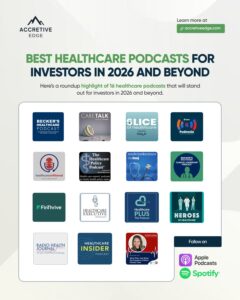Digital health startups don’t have the luxury of trial and error for long. A few wrong bets — on the wrong customer, messaging, or market entry strategy — can exhaust your resources quickly. That’s why competitive research should guide your product decisions, sales approach, and growth roadmap from day one.
Healthcare is particularly tricky. It’s not one single market, but an ecosystem. You’re often competing against:
- Incumbents with established relationships and regulatory knowledge
- Other startups with fresh funding or buzz
- Adjacent industries moving into healthcare, like retail or tech
- Even do-it-yourself solutions adopted by frustrated patients
Healthcare, with more than 907,000 businesses and 20 million employees across the industry is expected to grow by 14% by 2028. In this kind of environment, gaining a foothold — and holding it — requires clarity on where you can compete and win.
This guide will give you a structured approach to healthcare market analysis, including, how to identify real competitors, uncover whitespace in the market, and avoid the costly mistake of chasing the wrong early customers
Identify The Right Healthcare Competitors (and Avoid Blind Spots)
Many startups begin by thinking they’re in a category of one. But the moment you step into the market, you’re up against a wide range of players — some obvious, some hidden.
A good healthcare competitive analysis starts with casting a wide net, then narrowing it down. The goal isn’t to list every player in healthcare, but to pinpoint the companies and solutions your customers might choose instead of you.
Understand The Four Types of Competitors
1. Direct Competitors
These offer almost the same product or service to the same customer base. If you’re building a mental health app for young adults, another app with the same focus is a direct rival.
2. Indirect Competitors
These solve the same problem using a different approach or target a different segment. A traditional in-person therapy clinic isn’t an app, but it still competes for the same mental health budget.
3. Substitute Solutions
These are often overlooked. They include DIY methods or unrelated products that still meet the customer’s underlying need. For example, a YouTube meditation channel could be a substitute for a stress-reduction app.
4. Potential New Entrants
These are players not in your lane today but likely to cross into it. Think: Amazon’s moves into virtual care, or a wearable tech company launching a chronic care solution.
Build A Focused Competitor List
Start with a broad discovery process:
- Use Google searches like “telehealth startups for diabetes” or “chronic care apps.”
- Check startup directories, funding databases, and marketplaces like Amazon (for devices or wellness tools).
- Look at who your potential customers mention in sales calls, social media, or community forums.
Then narrow your list to 5–10 competitors that really matter; those who are realistically in your customer’s consideration set. Include a mix of:
- Established players in your space
- Other startups solving the same or adjacent problems
- New or emerging models
The goal is clarity, not exhaustiveness. You want a list that can guide product, marketing, and positioning — not paralyze you.
Competitor Types in Digital Health
| Competitor type | Description | Example |
| Direct competitor | Same product, same market | Two mental health apps targeting young adults |
| Indirect competitor | Different method, same need | Mental health app vs. in-person therapy clinic |
| Substitute solution | Alternative way to solve the same problem | YouTube videos for stress relief |
| New entrant | Company outside your space entering your market | Tech giant launching a fitness + mental health app |
Research Your Competitors Like An Analyst
Once you’ve built a shortlist of competitors, the next step is to understand them deeply. This means going beyond surface-level comparisons and gathering insights into what they offer, how they deliver it, who they’re targeting, and how customers perceive them.
A strong competitor profile blends both primary and secondary research. Here’s how to do it effectively.
Primary Research: Get Firsthand Experience
This involves engaging directly with the product or its users. It’s often a more revealing source of insight.
- Try their product or service: Sign up for their app, attend a demo, or request a sales call. Note the onboarding flow, pricing transparency, and support experience.
- Talk to users: If you can, interview people who currently use their solution. Ask what they like, what frustrates them, and what made them choose that option.
- Run user surveys: If you have an audience (email list, social media), ask your users what tools they’ve tried before and why they switched (or didn’t).
Secondary Research: Gather Public Data
You can find a surprising amount of insight from what’s already online — if you know where to look.
- Websites and blogs: How do competitors describe themselves? What value propositions do they emphasize? Who are they clearly targeting?
- Product reviews: App Store and Google Play ratings reveal what real users think. So do sites like G2, TrustRadius, or GetApp.
- News and funding databases: Tools like Crunchbase, CB Insights, and PitchBook show which startups are getting traction, who’s investing in them, and how fast they’re growing.
- SEO and traffic tools: Platforms like SEMrush, Ahrefs, or SimilarWeb reveal their top traffic sources, keywords, and digital visibility.
- Social listening: Reddit, Twitter (now X), Quora, and Facebook groups often reveal unfiltered feedback about what’s working and what’s not.
Analyze Products, Features, and Services
After you’ve gathered data on your competitors, compare what they’re actually offering and how it stacks up against your own solution. You’re not just listing features here, but also identifying what matters to customers and where you can differentiate meaningfully.
Build a Side-By-Side Feature Comparison
Create a simple features matrix (example) to compare your product against each major competitor. Focus on criteria that influence customer decisions, such as:
- Core functionality: What does the product actually do? What conditions or use cases does it cover?
- User experience (UX): Is the product easy to navigate? Is onboarding simple? How responsive is support?
- Price and business model: Are they charging per use, per patient, subscription, or value-based pricing?
- Compliance and regulation: Are they HIPAA compliant? FDA-cleared? Are there clinical trial results or published outcomes?
- Integration: Do they work with EHRs, billing systems, or existing patient workflows?
- Accessibility and support: Is it available in multiple languages? Is there live support? Do they offer training?
This exercise can reveal:
- Gaps you need to close (e.g., we don’t offer EHR integration, but all competitors do)
- Differentiators to highlight (e.g., we support remote patient monitoring, but none of them do)
- Trade-offs to explain (e.g., our solution is simpler but more affordable)
Focus on What Matters Most to Customers
You shouldn’t match competitors feature for feature alone. Doing so could dilute your focus. Instead, emphasize also the benefits that set you apart. Tackle questions like:
- What features are decision-makers actually asking for?
- What frustrations or unmet needs do users report in competing tools?
- What do our current users love most, and why?
For example, if your app only supports two clinical specialties while a competitor supports five, that might seem like a weakness. But if those two are high-need, underserved specialties — say, rural mental health and addiction care — it may actually be a strength worth doubling down on.
Audit Their Go-To-Market and Positioning
A great product isn’t enough to win in healthcare. You also need to understand how your competitors are reaching customers, what story they’re telling, and which market segments they’re prioritizing. This part of the analysis reveals how competitors attract attention, earn trust, and generate growth.
Look at Their Messaging and Value Proposition
Start with their website and marketing materials. Ask:
- What pain points are they emphasizing?
- Is their messaging clinical and data-driven, or personal and patient-friendly?
- Do they lead with features, outcomes, or stories?
- How do they describe their product’s value in plain terms?
Look at taglines, headlines, and calls to action. These are usually one of the clearest signals of how a company wants to be perceived.
Identify Their Target Segment
Not every healthcare startup is chasing the same customer. Use clues like:
- Testimonials or case studies (Are they quoting hospital CIOs or private practice physicians?)
- Language and tone (Is the copy written for doctors, patients, or payers?)
- Pricing and onboarding (Is it enterprise-grade or self-serve?)
A competitor that targets large hospital systems will need very different messaging and sales infrastructure than one focused on small outpatient clinics or direct-to-consumer wellness.
Study Their Channels and Tactics
Look at how and where they go to market:
- Are they active on social media? If so, which platforms?
- Do they run paid ads on Google or LinkedIn?
- Are they producing blogs, webinars, or white papers?
- Are they speaking at healthcare conferences or listed on marketplaces?
You can also explore whether they’ve announced partnerships — with providers, payers, employers, or distributors. These partnerships often shape how they grow.
Examples Two Telehealth Startups, Two GTM Strategies
- One focuses on enterprise deals with health systems. It leads with ROI stats, integration features, and white-glove support.
- The other targets consumers. It uses Instagram ads, mobile-first onboarding, and testimonials from everyday users.
Both serve a “telehealth” market — but compete in very different ways.
Evaluate Traction And Performance
Understanding how well a competitor is performing helps you separate serious threats from background noise. It also gives you clues about what’s resonating in the market, and what’s not. While private company data can be hard to come by, there are plenty of indicators you can use to gauge traction.
Quantitative Signals to Look For
- Number of customers or users: Sometimes stated directly (e.g. “used by over 500 clinics”), or can be inferred from app download numbers or press releases.
- Funding and growth stage: Check platforms like Crunchbase, PitchBook, or CB Insights to see if they’ve raised recent rounds, how much, and from whom.
- Revenue (if available): Larger or public companies may disclose this. For others, look for quotes in news articles or investor interviews.
- User reviews and ratings: App stores, G2, Capterra, and healthcare review sites can give a sense of satisfaction or churn risk.
- Clinical outcomes (if relevant): Has the product been validated in trials? Are there measurable patient improvements or cost savings?
Qualitative Performance Indicators
- Customer feedback and pain points: Use forums, Reddit, and social listening tools to monitor what people are saying about the product in real life.
- Case studies and testimonials: What kind of outcomes do they highlight? Are they focused on satisfaction, ROI, access, or clinical impact?
- Awards, certifications, and press mentions: Recognition can signal credibility, especially in healthcare where trust matters.
Look for Patterns, Not Perfection
Your goal isn’t to find the perfect set of performance metrics. Instead, look for directional insight:
- Are they gaining traction with a specific audience or use case?
- Is there dissatisfaction you can use to your advantage?
- Are they struggling to scale or pivoting frequently?
If a competing app has high adoption but poor ratings due to bad support, that’s a weakness you could exploit by offering better service. Or, if a competitor just raised $30M and is rapidly expanding in your region, that’s a signal you need a solid defense — or a niche to differentiate yourself.
Turn Analysis into Strategy
Once you’ve gathered insights about your competitors, customers, and whitespace, the next step is to turn that data into clear actions that guide your product, marketing, and digital health startup positioning. Here’s how:
Use Strategic Frameworks to Clarify Your Position
Start by synthesizing what you’ve learned using common strategic tools:
SWOT Analysis
Assess your startup’s strengths, weaknesses, opportunities, and threats based on your competitor and market research.
- Strengths: What do you offer that competitors don’t?
- Weaknesses: Where do you fall behind — features, trust, reach?
- Opportunities: What gaps exist in the market that align with your product?
- Threats: Are there rising players or changing policies that could hurt your position?

Source: HealthcareSuccess
Competitor Matrix Or Checklist
Build a grid with competitors across the top and key product or market features down the side. Check off who offers what.
This helps reveal market norms, differentiators, and gaps. For example, you may discover all competitors support EHR integration except you, highlighting a gap to fix or a need to reposition.
2×2 Landscape Mapping
Plot competitors and your own startup on two critical dimensions for your market. That could be Affordability (low to high) vs Personalization (low to high). This reveals crowded areas and potential whitespace where you can position yourself.
Translate Insights Into Strategic Moves
Ask questions around what you’ll start doing now that you’ve identified market gaps. What you should stop doing based on what’s not working or not needed. And where you can double down because you have an edge. Some strategic decisions look like this:
- Add a must-have feature that nearly every competitor has.
- Simplify your pricing if competitors are winning on transparency.
- Pivot to focus on a niche segment where no one else is dominant.
- Adjust messaging to highlight a differentiator you discovered is rare.
Set Clear, Measurable Goals
Don’t just analyze, act. Tie your insights to real business goals, that could be:
- Launching an integration with [tool] within 3 months to close a competitive gap.
- Targeting 3 new customers in the under-served [segment] by Q4.
- Improving onboarding flow based on frustration seen in competitor reviews.
Treat your healthcare market analysis as a living strategy document that informs key planning cycles across product, marketing, and sales.
Deep Analysis Leads to Better Strategy in Healthcare
It’s easy to skip this part of GTM strategy. A quick glance at a few competitors, maybe a pricing page or two — and then back to building. But in healthcare, trust moves slow and deals are complex, and a shallow read of the market rarely holds up.
Taking time to understand the real landscape — who buyers compare you to, what alternatives they’ve already tried, where they’re still struggling — can help shape smarter decisions. Not just on messaging, but on what you build, who you sell to, and how you position for the conversations that actually move things forward.
The goal isn’t to cover everything, but to see clearly enough to make better calls.
If you’re working through this and want a partner to sharpen the thinking with you, we can help with real strategy, built with you.






